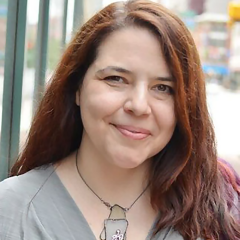
Speaker: Pamela Gay
Senior Scientist @planetarysci (Planetary Science Institute)
In addition to teaching astronomy through podcasts, Dr Gay is Director of CosmoQuest, an online facility for learning and doing astronomy. In spring of 2019, CosmoQuest community members will play a significant role in the OSIRIS-REx mission by helping map this asteroids surface. As part of CosmoQuest, she also hosts the Daily Space, a news show on Twitch and YouTube.
While she is most well known for her public-facing science communications efforts, behind the scenes, Dr. Gay is a programer innovating how citizen science can advance science. From experimenting with UX to experimenting with machine learning, her team combines big data number crunching and web development to get at new understandings of the Universe.
Dr. Gay is a senior scientist at the Planetary Science Institute, a 2018 Podcasting Hall of Fame inductee, and recipient of the 2019 Isaac Asimov Science Award. She can be seen on television on shows like Strange Evidence and The Universe, her writing has appeared in Sky & Telescope, Lightspeed, and other magazines, and she regularly consults on science fiction novels.
In addition to her academic work, Dr Gay is also a space artist who turns the latest news in planetary science and turns it into artwork and poetry. She has sold more than 100 original paintings to personal collectors, coffee shops, and everything in-between.
KEYNOTE
When Machine Learning Can't Replace the Human
In our modern era of digital cameras and automated imaging, hoards of data are piling up that can be used to solve a myriad of problems: but only if there is a way to categorise and tag the images. Machine Learning is making great strides, but despite all attempts to make it the hammer that bends all nails, there are still problems that require human vision. In this talk, we will look at the case of an asteroid - a 500m across rock named Bennu. While unimpressive in size, this orbiting rubble pile has posed an intimidating challenge to its mission team: How can a safe spot to get a sample (or 3) be found quickly on an object with half a million hazards (give or take). The answer? Use humans as part of the algorithm. This solution presents its own problems, ranging from griefers to slackers to ethical considerations, but this solution works. Come for the computer science, and stay for the astronomy, as we explore how creative software solutions let scientists explore our solar system.

